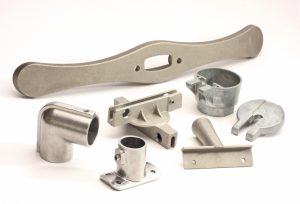
Die Casting

The high pressure die casting process is widely used for producing large volumes of zinc, aluminum, and magnesium castings of intricate shape. The essential feature of die casting is the use of permanent metal dies into which the molten metal is injected under high pressure.
The rate of production of this type of casting depends largely on the complexity of design, the sectional thickness of the casting, and the properties of the metal. Great care must be taken with the design and gating to avoid high pressure porosity to which this process is prone. Where pressure tightness is essential the buyer can arrange for special processing such as “vacuum die casting.”
Advantages
Low cost castings, high degree of complexity and good surface finish. Die Casting allows for considerable design flexibility. High degree of accuracy. As with other processes inserts can be cast in if needed to enhance design capability. Suitable for relatively low meting point metals (1600F) (871C) (lead, zinc, aluminum, magnesium, and some copper alloys) and high volume.
Disadvantages
Limited on size of casting. Most suitable for small castings up to approximately 75 lbs. Equipment and die cost are high. Some risk of porosity. Good design is essential.
Precision Molding
Die Casting
| Typical dimensional tolerances, inches | ± .001″, ± .015″ |
| Relative cost in quantity | Lowest |
| Relative cost for small number | Highest |
| Permissible weight of casting | 75 lbs. |
| Thinnest section castable, inches | 1/32″ |
| Relative surface finish | Best |
| Relative ease of casting complex design | Good |
| Relative ease of changing design in production | Poorest |
| Range of alloys that can be cast | Aluminum base preferable |
Parting Line Influence
When Parting lines are considered, very close tolerances are difficult to obtain. A parting line absorbs fractions of inches per inch. A foundry is doing well to hold a parting line to 0.015 inch. Additional measurement is added to the casting tolerance.
